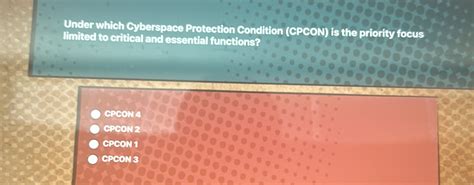Sherly
You need 3 min read
Post on Feb 03, 2025
Table of Contents

Under Which Cyberspace Protection Condition (CPCON) is the Priority Focus?
Understanding Cyberspace Protection Conditions (CPCONs) is crucial for effective cybersecurity. CPCONs represent the overall security posture of a system or network, influencing resource allocation and response strategies. But which CPCON warrants the most immediate and concentrated attention? The answer isn't straightforward and depends on several factors, but prioritizing certain CPCONs is essential for minimizing risk and maintaining operational integrity.
Defining Cyberspace Protection Conditions (CPCONs)
Before diving into prioritization, let's establish a clear understanding of CPCONs. These conditions represent a spectrum of threat levels and operational statuses. They typically range from normal operational levels to heightened alert states reflecting escalating threats. While the specific naming and definitions can vary between organizations and government agencies, common elements include:
- Normal: Routine operations, with standard security measures in place. This is the baseline state.
- Elevated: Increased threat awareness, potential for minor incidents, proactive security measures enhanced.
- High: Significant threat indicated, increased likelihood of attacks, heightened security posture and response readiness.
- Severe: Imminent or ongoing major cyberattack, significant disruption likely, all available resources mobilized.
Factors Influencing CPCON Priority Focus
Determining which CPCON demands immediate focus is complex and depends on several crucial factors:
- Threat Intelligence: Real-time threat intelligence, gleaned from various sources (e.g., threat feeds, security information and event management (SIEM) systems, vulnerability scanners), is paramount. Specific, credible threats against your organization will automatically elevate the CPCON.
- Asset Criticality: The value and sensitivity of the assets at risk directly impact CPCON prioritization. Systems holding sensitive personal data, financial records, or critical infrastructure components require more immediate attention than less critical systems.
- Vulnerability Assessment: Regular vulnerability assessments help identify weaknesses exploitable by attackers. The severity and number of vulnerabilities discovered directly correlate with the necessary CPCON. A critical vulnerability detected warrants immediate elevation of the CPCON.
- Incident Response Capabilities: The organization's ability to respond to and mitigate cyber incidents plays a role. Organizations with robust incident response plans and well-trained personnel can manage certain threats effectively, even at elevated CPCONs. However, lacking preparedness dictates immediate attention to bolstering defenses.
- Resource Availability: The resources available for cybersecurity – budget, personnel, tools – significantly impact the ability to manage different CPCONs. Limited resources might necessitate prioritizing specific CPCONs based on their potential impact.
Prioritizing CPCONs: A Practical Approach
Prioritizing CPCONs is not a one-size-fits-all process. However, a structured approach can help:
- Continuous Monitoring: Constantly monitor threat intelligence, system logs, and security alerts.
- Risk Assessment: Regularly assess the risks associated with different systems and assets.
- Incident Response Planning: Develop and regularly test robust incident response plans.
- Vulnerability Management: Implement a proactive vulnerability management program to identify and remediate weaknesses promptly.
- Resource Allocation: Allocate resources strategically, focusing on the most critical assets and threats.
In summary: While a "normal" CPCON is the desired state, effectively managing all CPCONs requires a dynamic approach. Prioritization hinges on threat intelligence, asset criticality, vulnerability assessments, incident response capabilities, and resource availability. A proactive, risk-based approach, emphasizing continuous monitoring and robust security measures, is essential for ensuring the organization's resilience in the face of evolving cyber threats. Proactive measures are far less costly and disruptive than reactive responses to a severe CPCON.
Thanks for visiting this site! We hope you enjoyed this article.
